How to properly graft to Hylocereus root stocks.
Page Contents
|
Hylocereus root stocks tend to get very woody in the core relatively fast. This makes sense, as they are a climbing cactus which need to be relatively strong to be able to climb up things without breaking their stem. A woody core helps strengthen the cactus. A woody core is exactly what we, as grafters, do not want. Scions tend to heal poorly to hard woody cores and do not grow as fast. So one step in preparing Hylocereus stocks is preventing woody cores. |
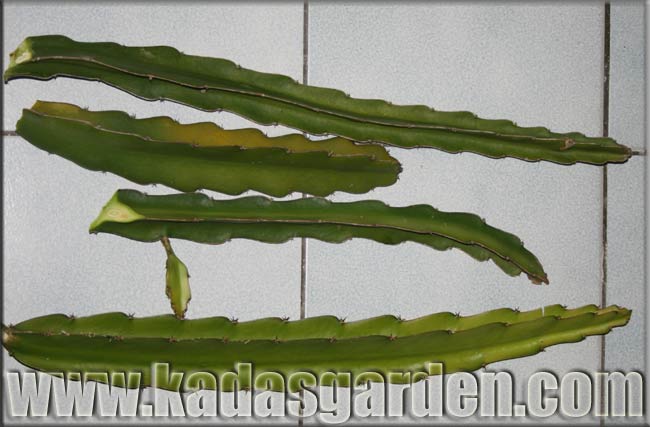
New growth on bottom (1), old growth on top (3) |
New growth is very soft and flexible, and is therefor the ideal candidate for a cutting to be used as a rootstock. Because Hylocerues sp. cuttings don't always root right way, they can sometimes begin getting tough before they are adequately rooted. There is a way around this involving cutting off the apical meristem, where the cactus grows from, and all the areoles to prevent offsets from forming. This will lead to a cactus unable to grow, or send out new stems. It is thus stuck as is, until a new areole or growth point is grafted onto it, thus allowing it to grow out, though the scion of your choice. |
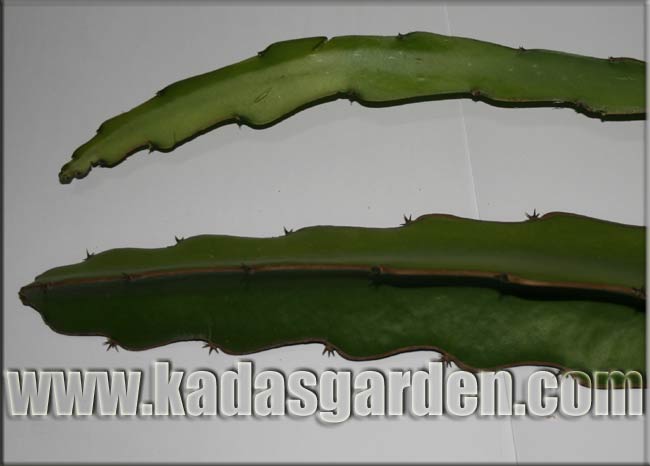
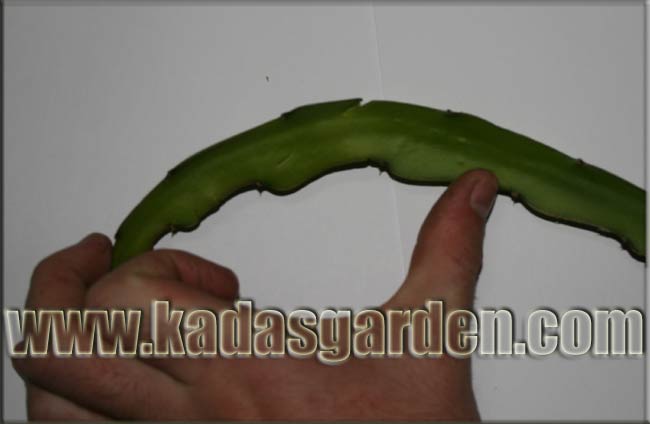

Top: New growth upper, old growth lower. Middle: New growth is very flexible, and not yet woody. Bottom: Old growth is not flexible, and quite woody in the center. |
|
Because new growth should be selected for cuttings for future grafting use, it is very useful to have some "mother" plants to take cuttings from. In general vine cacti start at eh forest floor, and climb up something to find light. This is a common truth for many vine plants, including such common things like morning glories. Their habit is, seeds fall to the ground and start to grow in low light. they stretch up as fast as they can to find light, once once they reach the "top", where there is light, they are able to full out in a more sturdy/bushy fashion. With cacti that receive low light, they tend to stretch (etiolated) to grow faster up to gain more light. this results in skinny growth. With Hylcoereus species this means skinny stems that become very woody very fast. The exact opposite of what is needed for a grafting stock. What we want is super fat thick stems that are not woody. How can you tell its new growth? The flesh will feel more rubbery when its new, and more waxy/smooth when old. Also new growth is far more flexible, old growth is very hard. See photos of the ribs with old, semi-new and new growth. See if you can tell which is which.
To avoid skinny stems, provide adequate light for the mother plants. Grow them in full sun, with good heat and humidity and ample water. This will result in very healthy stems for cuttings. If not enough light is provided you will get skinny stems of mediocre quality for grafting stocks.
|
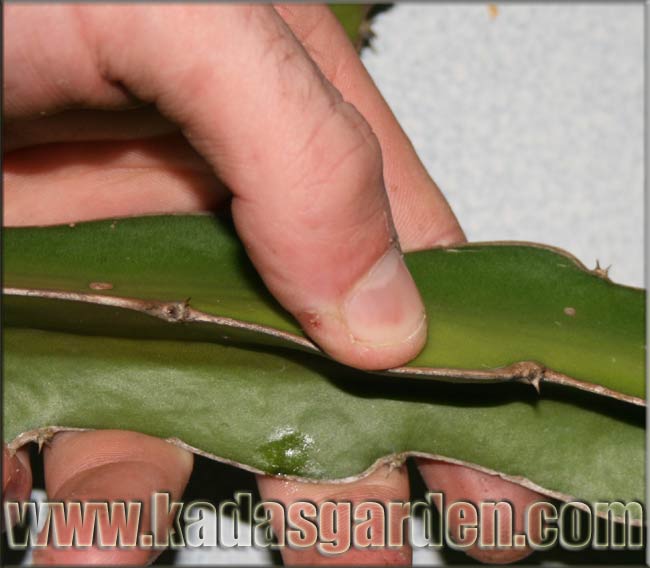
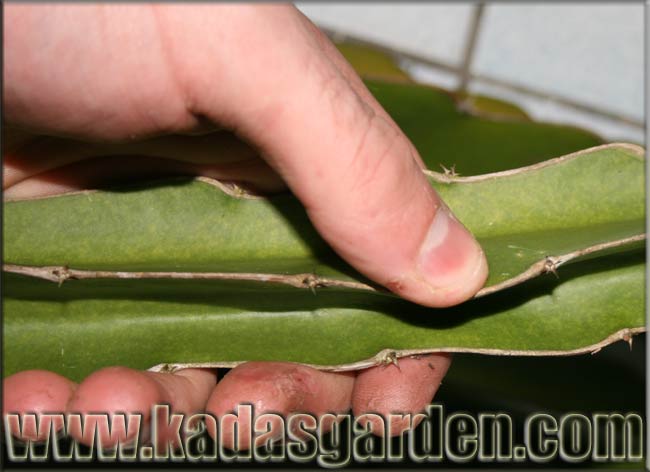
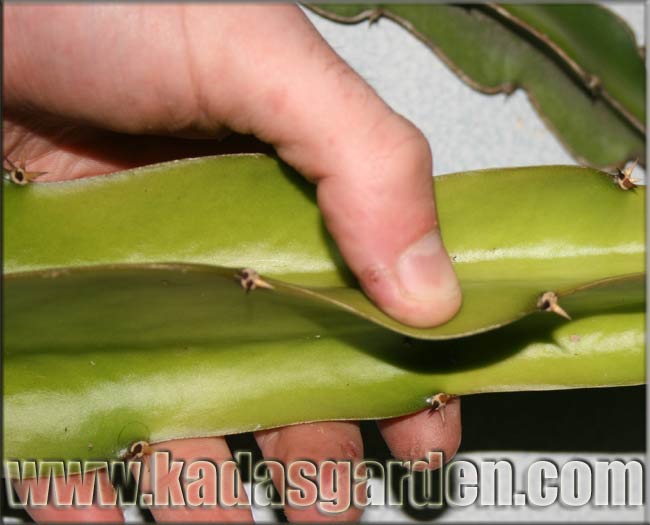
Top to bottom - Old, semi-new and new growth. |
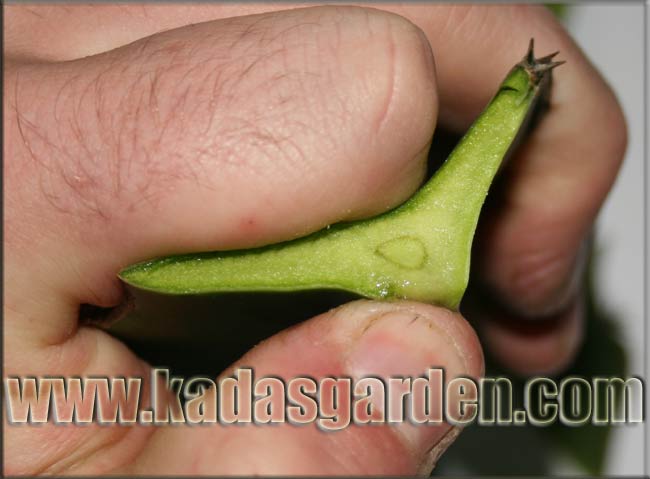

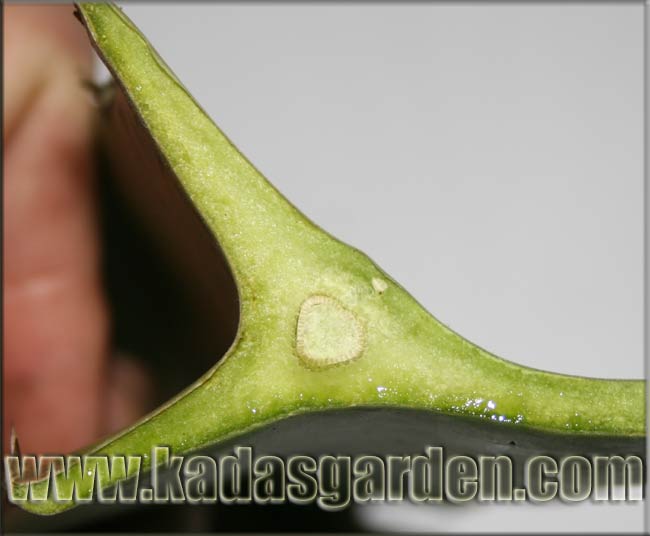
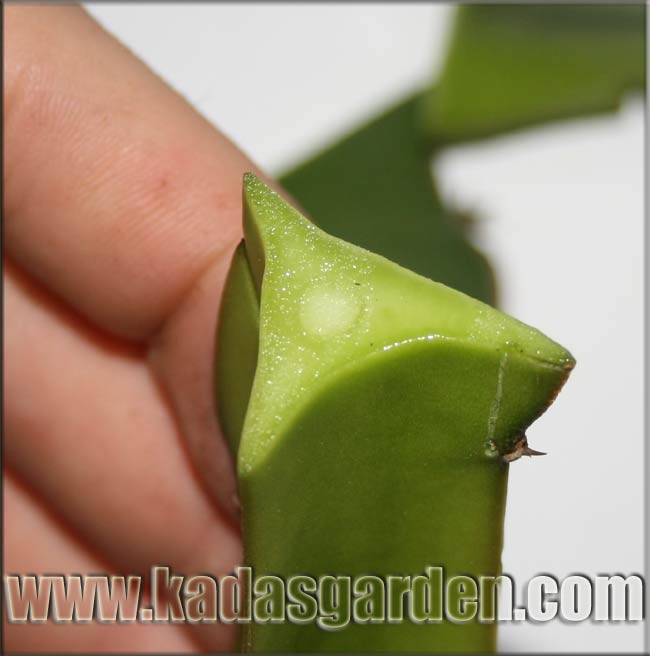
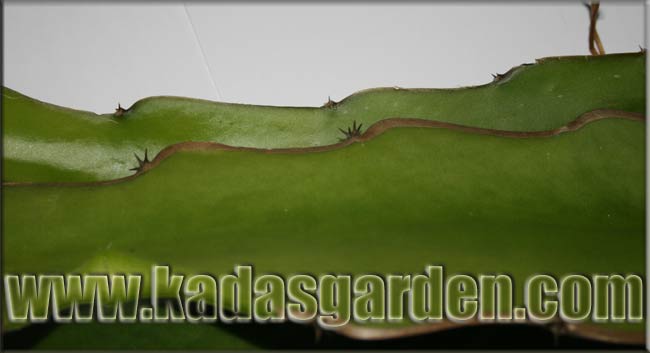
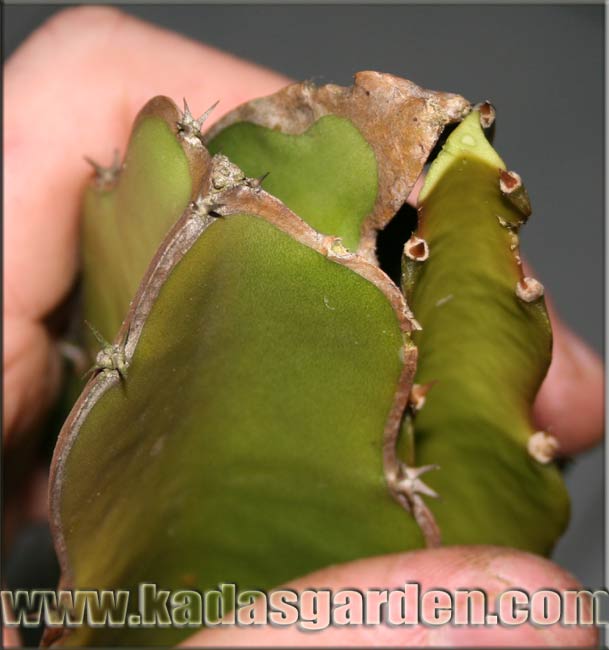
More examples of new growth vs old growth. Left to right: 1. Old growth very firm. 2. New growth easily crushed. 3. Old growths' core very woody. 4. New growths' core quite succulent. 5. Edges of ribs are brown and hard in old growth. 6. The tips are also very rigid and brown on old growth, whereas new growth is succulent and green. |
|
We have our mothers well grown and producing good quality fat new growth for out cuttings. Hack them off the mother plant at the length you desire. we tend to stick to around 30cm long cuts for root stocks, this is an all around good size. that said we have successfully grafted to 1-3000cm tall root stocks. Its really up to you, but 15-60cm tall root stocks are the most manageable sizes for most peoples needs. Keep in mind the more root stock surface area (meaning taller) the more area the plant can absorb light and turn it into usable plant sugars (photosynthesis). With areoels all clipped off the extra height matters not with offsetting, but more on that further down. Taller, in this situation, is just a matter of convenience and availability to you.
There is now a cut off stem, say 40cm long. There are no roots and there is still an apical mersitem and lots of areoles, in which it may offset from. First lets look at roots. You cut it off the plant, and the bottom of your cutting (where you cut) is flat, or perhaps angled. You can root as is, or you can try to make stronger roots. If you cut the plant right at the mother plants areole, the cut surface is probably quite small. This, in most cases, means the roots will not be as large as fast. Cut so that the cut area is large. This increases the surface area in which roots are most liekly to come from. That said, and keeping in mind this is a tropical vine cactus that uses aerial roots to cling to things, roots do commonly form from out of the skin. We have found, that cuts with larger surface area cut, rather than cut right at the base of the join from offshoot and mother where it is narrower, have larger root systems. It is important to note that when cut like this rot happens more frequently and also takes longer to root. Plants cut right at the join tend not to rot as frequently and root much faster. Just an observation, at least in our Southern Taiwan climate. |
|
Once you cut your cut, it is also advantageous to bevel the ribs up. Making a seemingly "flat tipped arrow". This also helps in creating a larger, stronger root system. This is not necessary, but if your ready this page your looking to improve grafting quality with Hylocereus, not just slap a scion on any old dragon fruit cut. See photo to the right.
With roots all taken care of, its time to concentrate on the stem itself and get it into prime grafting condition. |
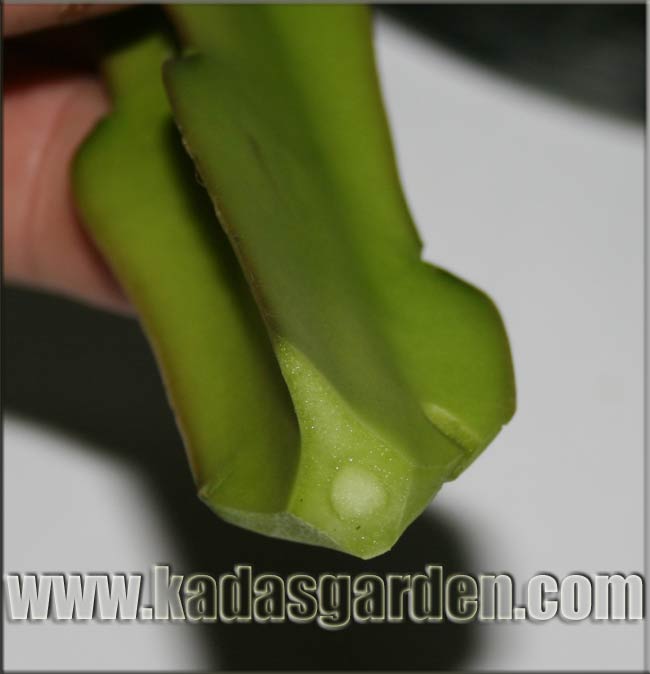
Base of new cutting with beveled ribs to enhance root strength. |
We now look to the growth points of any cactus. Where leafy plants have nodes, where leaves and new shoots emerge from, cacti have areoles; where spine/wool and new growth (usually) comes from. Without getting into exceptions, as we are only speaking of Hylocereus here, new growth only emerges from the areoles (where the spines are) and the apical meristem; the central growth point found at the end of the stem. If the cactus is robbed of these new growth outlets, it cannot grow new shoots (so the theory goes, there are exceptions for sure). |
If you ever compare new vs old growth, you can really notice a difference in the texture of the skin and the cortex of the cactus. New growth is very soft (and edible by the way!) while old growth is very tough in the skin and also develops a strong waxy layer over the skin which helps prevent dehydration in times of drought (a common feature in cacti). First begin by slicing off the very tip of the apical mersitem, or end of the cutting. You do not need to cut much. You want to accomplish 2 things with this. 1: stop new growth. 2: keep the tip very soft and succulent, preventing it from becoming woody. If you cut too far down, you will eventually get woody cores...not good. Only a matter of mm's are required here.
This stem can no longer continue growing up, much like a pinched leafy plant, such as a rose, it will now send out new stems from the nodes, or areoles in our case. This also allows cores to become woody as they need to support not only the weight of the new stems but the water/nutrient supply from the roots. We now need to prevent this from happening because we want all the water and nutrients going to our grafted scion, not new shoots from the stock. It is here where most people do not spend the time and why some don't enjoy growing with Hylocereus. That said, its also the most time consuming process and not entirely needed, but the results are simply the best possible....Cut out all the areoles. Not a bad practice with any species of root stock actually, but here with Hylocereus especially.
Yet another advantage to new growth is the fact they are so soft and easy to work. Like carving watermelon compared to a carrot. take a razor, sharp knife or even your finger nails if they are long and you are lazy (guilty) and cut out the areoles. Try not to remove too much flesh, but be sure to get in deep enough to get rid of any areole and future growth chances. Sound like some kind of dragon fruit psycho, I know. We like to make a V cut. Cut down the rib from the top and make another cut up form the bottom to take out a V shape where the areole is. see photos to the right.
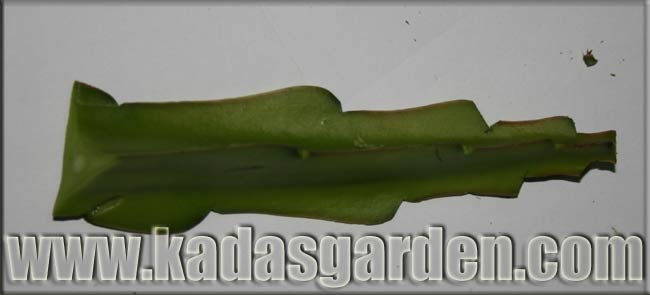
The tip is cut, and all areoles removed. This stem can't grow on it's own now. |
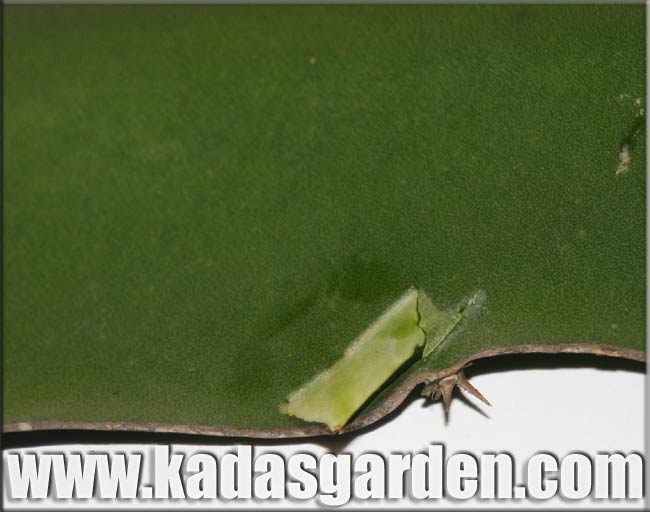
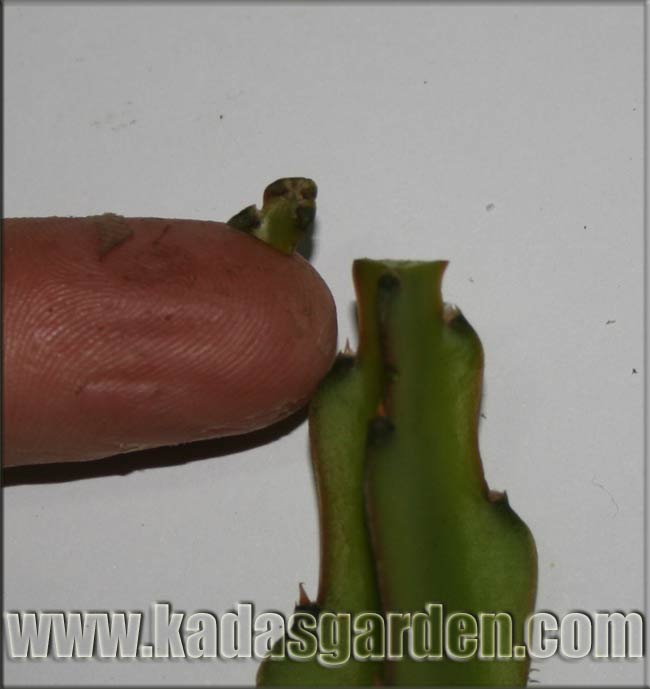
Top: See the waxy skin on old growth. Bottom: Remove the very tip of the stem to stop new growth.
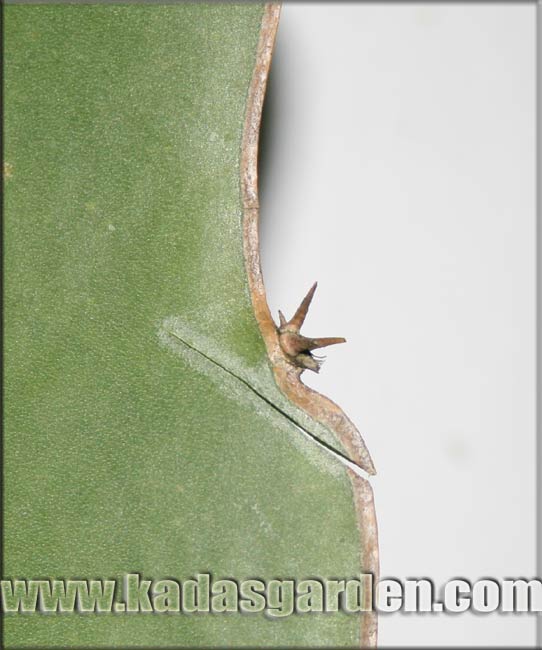
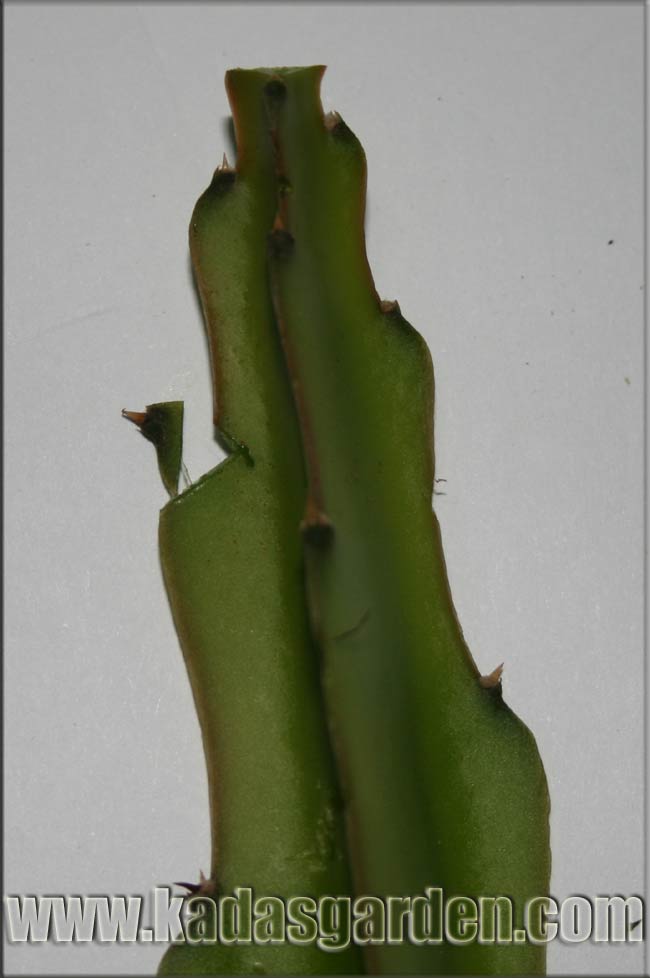
Cut out the areoles to prevent new shoots from developing.
|
|
Now all the time consuming work, at least human work, has ended and its time to root them up. Hylocereus are very easy to dehydrate without roots. When you root them you must NOT leave them in the sun. First, following standard cactus cutting procedure, leave the cuttings on a table to allow all the cuts to dry and callous for a few days. This allows them to heal their wounds and fend off infection. Do not put in sun, cold, moist areas or complete darkness. A well lit kitchen counter or table is ideal. Try to keep above 20C if you can. Once healed, place teh cuttings into a well drained, loose substrate. Its good to have oxygen int eh soil, so something not compact is best for rooting. Later you can repot to almost anything and it will grow, but this stage is sensitive. It is important to keep the soil dry. Hylocereus with wet skin and no roots rot very easily. So pot them up and don't water them until they show root growth. Its good to pot them because Hylocereus root on dark surfaces. This is probabyl an adaptation to being a vine cactus and clinging to surfaces with aerial roots. When the plant leans against a tree, for example, it is dark and liekly more humid and it throws out roots to grad teh tree and help secure its way up to the canopy. Long story short, it's good to pot them in soil to keep the bottom dark and induce rooting.
Once rooted, begin watering. Allow the soil to dry out in between watering. Hylcoereus can grow in very loose or very heavy soils. it is probabyl more important to think about your scions than your stock with this step. While rooting we keep all our Hylocereus stocks under our benches in our green house. They receive medium light and no direct light, its seems perfect. Once good root systems are developed bring to stronger light. From cutting them off the mother to ready to graft is about 2-3 months in good conditions.
Because the stem cannot grow out on its own, you cut out all possible growth points, all it does is get more and more plump. As you can tell, Hylocereus is often a deeply ribber cactus, generally with 3 ribs. When you let it plump up a lot, it actually bulges out instead of sinks in and you get what looks like an obese triangle from the top view. This is what we wait for to graft, super fat Hylocereus stocks that think they are a Myrtillocactus. Once this is accomplished, follow standard grafting procedure and enjoy a wonderful super fast growing Hylocereus stock.
This technique is also very useful for grafting with Acanthocereus, which is equally fast, if not more so.
|
|
|



